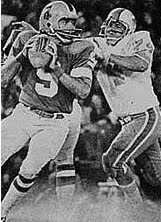
Jerry Rice
TOP 10 RECEPTIONS
1- Herman Moore, 1995 Detroit Lions
123 rec., 1686 yards, 13.7 avg., 14 TD
2(tied)- Cris Carter, 1994 Minnesota Vikings
122 rec., 1256 yards, 10.3 avg., 7 TD
2(tied)- Jerry Rice, 1995 San Francisco 49ers
122 rec., 1848 yards, 15.1 avg., 15 TD
2(tied)- Cris Carter, 1995 Minnesota Vikings
122 rec., 1371 yards, 11.2 avg., 17 TD
5- Isaac Bruce, 1995 St. Louis Rams
119 rec., 1781 yards, 15.0 avg., 13 TD
6(tied)- Sterling Sharpe, 1993 Green Bay Packers
112 rec., 1274 yards, 11.4 avg., 11 TD
6(tied)- Jerry Rice, 1994 San Francisco 49ers
112 rec., 1499 yards, 13.4 avg., 13 TD
8(tied)- Terance Mathis, 1994 Atlanta Falcons
111 rec., 1342 yards, 12.1 avg., 11 TD
8(tied)- Michael Irvin, 1995 Dallas Cowboys
111 rec., 1603 yards, 14.4 avg., 10 TD
10(tied)-Sterling Sharpe, 1992 Green Bay Packers
108 rec., 1461 yards, 13.5 avg., 13 TD
10(tied)-Brett Perriman, 1995 Detroit Lions
108 rec., 1488 yards, 13.8 avg., 9 TD
10(tied)-Jerry Rice, 1996 San Francisco 49ers
108 rec., 1254 yards, 11.6 avg., 8 TD

Herman Moore

Cris Carter
BEST BY FRANCHISES NOT IN TOP 10
Phoenix/Arizona Cardinals: Larry Centers, 1995*
101 rec., 962 yards, 9.5 avg., 2 TD
Carolina Panthers: Muhsin Muhammad, 1999**
96 rec., 1253 yards, 13.1 avg., 8 TD
Philadelphia Eagles: Irving Fryar, 1996
88 rec., 1195 yards, 13.6 avg., 11 TD
Chicago Bears: Bobby Engram, 1999
88 rec., 947 yards, 10.8 avg., 4 TD
New Orleans Saints: Quinn Early, 1994
82 rec., 894 yards, 10.9 avg., 4 TD
New York Giants: Amani Toomer, 1999
79 rec., 1183 yards, 15.0 avg., 6 TD
Washington Redskins: Gary Clark, 1990
75 rec., 1112 yards, 14.8 avg., 8 TD
Tampa Bay Buccaneers: Mike Alstott, 1996*
65 rec., 557 yards, 8.6 avg., 3 TD
*Running Back
**Panthers joined NFL in 1995

Isaac Bruce

Sterling Sharpe
TOP 10 YARDS
1- Jerry Rice, 1995 San Francisco 49ers
1848 yards, 122 rec., 15.1 avg., 15 TD
2- Isaac Bruce, 1995 St. Louis Rams
1781 yards, 119 rec., 15.0 avg., 13 TD
3- Herman Moore, 1995 Detroit Lions
1686 yards, 123 rec., 13.7 avg., 14 TD
4- Michael Irvin, 1995 Dallas Cowboys
1603 yards, 111 rec., 14.4 avg., 10 TD
5- Rob Moore, 1997 Arizona Cardinals
1584 yards, 97 rec., 16.3 avg., 8 TD
6- Michael Irvin, 1991 Dallas Cowboys
1523 yards, 93 rec., 16.4 avg., 8 TD
7- Jerry Rice, 1993 San Francisco 49ers
1503 yards, 98 rec., 15.3 avg., 15 TD
8- Jerry Rice, 1990 San Francisco 49ers
1502 yards, 100 rec., 15.0 avg., 13 TD
9- Jerry Rice, 1994 San Francisco 49ers
1499 yards, 112 rec., 13.4 avg., 13 TD
10-Robert Brooks, 1995 Green Bay Packers
1497 yards, 102 rec., 14.7 avg., 13 TD

Michael Irvin

Rob Moore
BEST BY FRANCHISES NOT IN TOP 10
Minnesota Vikings: Randy Moss, 1999
1413 yards, 80 rec., 17.7 avg., 11 TD
Chicago Bears: Marcus Robinson, 1999
1400 yards, 84 rec., 16.7 avg., 9 TD
Washington Redskins: Henry Ellard, 1994
1397 yards, 74 rec., 18.9 avg., 6 TD
Atlanta Falcons: Terance Mathis, 1994
1342 yards, 111 rec., 12.1 avg., 11 TD
Philadelphia Eagles: Irving Fryar, 1997
1316 yards, 86 rec., 15.3 avg., 6 TD
Carolina Panthers: Muhsin Muhammad, 1999*
1253 yards, 96 rec., 13.1 avg., 8 TD
New York Giants: Amani Toomer, 1999
1183 yards, 79 rec., 15.0 avg., 6 TD
New Orleans Saints: Quinn Early, 1995
1087 yards, 81 rec., 13.4 avg., 8 TD
Tampa Bay Buccaneers: Courtney Hawkins, 1993
933 yards, 62 rec., 15.0 avg., 5 TD
*Panthers joined NFL in 1995

Terance Mathis

Robert Brooks








































